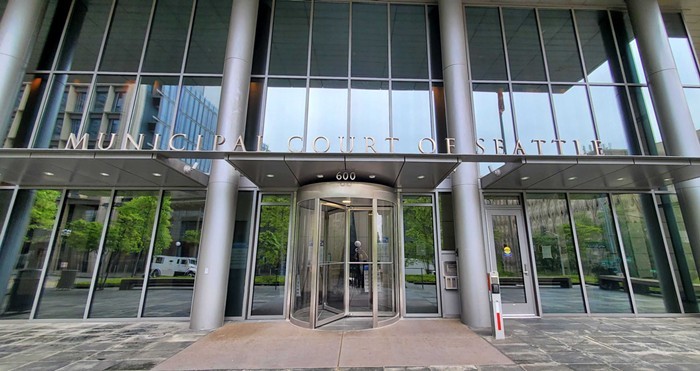Jacobs, who answered her phone with the sunny "Hello?" of a woman accustomed to taking calls from reporters for lifestyle magazines, didn't take long to cut me off when I told her I was calling about the precarious, barely waist-high perch. (A friend refers to it as the Diving Board.) Minutes later, library spokesperson Andra Addison returned my call. "The building was built to code. So I am not understanding your question," Addison said. City Attorney Tom Carr, whose lead tort attorney combed the library for liability issues, also refused to take the bait. "There's nothing in the building that you'd call an inherent hazard," Carr said.
Unsatisfied, I tried Department of Planning and Development spokesperson Alan Justad, who said the railing meets the city's building code. However, Justad told me ominously, "the code doesn't regulate whether things can be climbed. The building "definitely has that dizzying feeling," Justad adds.
Dizzying would also be a good word to describe the city's ever-expanding (last count: $25 million) budget shortfall. And it could get worse: In the next few months, a judge will consider whether the city has to reimburse City Light ratepayers directly for an estimated $24 million in illegal streetlight charges, and, if so, how quickly. The city argued that direct refunds would be a logistical nightmare. That argument could come back to haunt the city. If the judge chooses the simplest possible solution--requiring the city to pay ratepayers back immediately instead of spreading payments over four years--the deficit could climb "even higher than the city estimated," council member Peter Steinbrueck says grimly.
Late last week, Steinbrueck joined forces with the scruffy transportation guerrillas at the People's Waterfront Coalition, AKA monorail revolutionary Grant Cogswell and Allied Arts defector Cary Moon. Last Friday, Steinbrueck signed a PWC-drafted letter calling on the Washington State Department of Transportation to include the coalition's innovative no-highway viaduct proposal in its environmental impact statement. Steinbrueck may have crossed the line from merely credulous to downright quixotic: The comment period for the viaduct EIS is almost over, and the PWC proposal is nowhere to be seen.
Lost in the fog of another transportation war: council prez Jan Drago's terse e-mail to Seattle Times columnist Joni Balter, who recently gave the mic in her column to engineer and monorail critic Jon Magnusson,. "I think it's important that you understand the other side of the issue," Drago said; namely, Magnusson's financial connection to Second Avenue monorail opponents. "Please do more research."


















